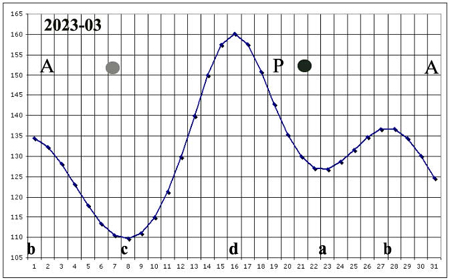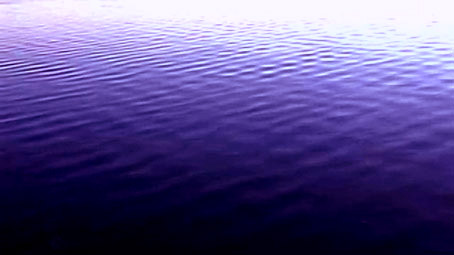Processes in seeds and water.
In the previous section, I presented how the tidal phenomenon is produced, thanks to cumulative-dissipative processes.
In seeds.
As already mentioned in the first part of the site, in seeds immobile in the ground, the two phases of the processes can occur at distinct periods of a calendar.
One period for the cumulative phase (b-c; d-a), the next period for the dissipative phase (a-b; c-d).
In water.
As already mentioned, in liquid water, the two processes—cumulative and dissipative—can occur at any time, alternating.
This alternation occurs both when the water volume increases and when it decreases. Therefore, both at high tide and low tide.
At any given moment, the state of the tide is the result of a dynamic balance. When the two processes, cumulative and dissipative, occur in small groups of water molecules, each group independent of the other, there's no problem. We perceive what's happening
Problems for perceiving the phenomenon.
Not so when the two processes, the cumulative and the dissipative, occur in large groups of water molecules, every one or two seconds.
Then what I call "water figures" or "density waves" are formed.
Considering the shallow depth of the water, just a few meters, completely still, I wonder if the different water levels between one point and the next could indicate the difference in water volume between the cumulative and dissipative phases.
Perhaps a clue might come from the following photo, where you can see that the water features do not appear in the part of the lagoon where the water level is very low.
Phenomena that challenge psychologists.
Our mind doesn't accept these phenomena as real, because they make no sense to it.
To see these phenomena, I'm forced to see them through a camera monitor, or in video footage. In that case, my mind tolerates and accepts seeing them. Not so when seen directly.
In truth, these phenomena are usually ignored.
Our minds typically censor these phenomena, partly because we see what is consistent with what we already know. Our minds are not designed to perceive the unusual.
These phenomena compete with what we consider important for our lives, which already occupy our attention—a limited resource, given that we have limited time
The first ideas occupy the mind.
Ultimately, I too have found myself grappling with Jean Fourastié's statement: that man sees what he expects to see. He perceives only what is consistent with what is already in the content of his thought.
The ideas that arrive first occupy space and block the brain to their advantage, denying access to those that didn't arrive in time.
Ideas are intolerant of one another.
Our mind censors these phenomena.
Indeed, these phenomena, when seen in person, are as if censored by our mind, if they are not already part of our experience.
Lusenzo is in the center of a city of forty-nine thousand inhabitants. The place where the recordings took place is popular, being a public park.
To my knowledge, no one has ever reported the phenomena that occur there, those I call "water figures" and "density waves."
As for me.
After two years of frequent excursions to Luzenso, to study how the tide develops, I only noticed the phenomenon when, on the camera monitor, I saw that it was about to record something very different from what I was about to see directly, at the same moment.
Yes, exactly. I understood how we humans fail to perceive the unusual when it is in stark contrast to our previous experience.
On the other hand, it is possible to accept the unusual when seen on video.
In fact, not all of us, but a good portion of us, perceive water features and density waves without difficulty when they are presented in photos and videos.
A question of patience.
At this point, some readers may wonder why I persisted for two years in investigating how the tides are formed, without success. I wanted to record the phenomenon I called "concave water figures," which I had seen twice and which could be closely related to the tides.
The first time I saw this phenomenon was in 1954, when I was 11 years old, the day after the Feast of the Redeemer in Venice.
The second time I saw them was the day I went to Chioggia, with the sole intention of purchasing maps to determine where to conduct observations in the lagoon for this research. It was March 19, 2005.
In these "concave water figures," one side of each figure, alternating with the other sides, would frantically rise and fall relative to the central concave area, at a rate that could be as frequent as once every two seconds. The phenomenon was more pronounced where there was greater depth.
I noticed the "concave water figures" phenomenon because it develops violently.
I spoke about it with a fisherman.
When I happened to mention it to an elderly fisherman from Chioggia, someone who has spent his entire life between the lagoon and the sea, and I asked him if he'd ever seen such a phenomenon, he looked at me strangely, as if I might have come from Mars.
Politely, with his Chioggia PGI accent, which I've always liked, he quickly dismissed the subject, saying that I had certainly seen a wave.
But immediately afterward, he told me that he, too, had seen something strange and wonderful more than once, like magical reflections on the water, when he returned to the lagoon after a night at sea.
A rare phenomenon.
Evidently, the phenomenon of "concave water figures" is rare, but they served me indirectly as bait.
In the sense that, while I was waiting for them—a rare phenomenon—I encountered the useful figures, the ones that showed me how the tide develops.
I call these figures "water figures" and "density waves." When they occur, they are characterized by continuously alternating bumps and valleys.
Such figures, however, are generally not accepted by our minds.
Normally.
However, when presented in photographs and videos, "water patterns" and "density waves" can generally be perceived without difficulty.
It's important to note that the ability to perceive the phenomenon varies from person to person, both when viewing it directly and when viewed through a video.
This is interesting for understanding how our mind generally reacts to novelty.
Ultimately, when we perceive with all our senses an event that isn't yet part of our experience, and which we don't know how to interpret, our mind censors it and doesn't see it.
Or it's content to interpret the phenomenon in some plausible way and move on.
Conversely, when we see a scene in a movie, we are more tolerant of novelty, regardless of whether what we see is true or false, for the simple reason that we're already aware that it's fiction.




